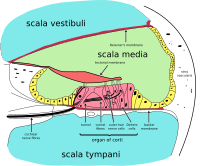
Photo from wikipedia
Epidemiological evidence suggests a strict correlation between sudden sensorineural hearing loss (SSNHL) and cerebrovascular disorders. Leukoaraiosis represents a diffuse alteration of the periventricular and subcortical white matter. The aim of… Click to show full abstract
Epidemiological evidence suggests a strict correlation between sudden sensorineural hearing loss (SSNHL) and cerebrovascular disorders. Leukoaraiosis represents a diffuse alteration of the periventricular and subcortical white matter. The aim of our study was to verify if the presence of white matter hyperintensity (WMH) was higher in patients affected by SSNHL compared to controls and evaluate the correlation between WMH and the cardiovascular risk factors, hearing level, and the response to therapy in SSNHL patients. The study group included 36 subjects affected by unilateral SSNHL. Thirty-six age- and sex-matched normal subjects with a negative history of SSNHL were used as controls. All patients underwent magnetic resonance imaging (MRI) (1.5 Tesla GE Signa) and the extent of leukoaraiosis was assessed with the Fazekas scale. The results of the present study demonstrate a high prevalence of WMH in SSNHL patients compared to controls confirming the hypothesis of a vascular impairment in SSNHL patients. The higher recovery rate in patients with greater periventricular white matter hyperintensity (PWMH) may suggest a vascular etiology that is still responsive to medical treatment. We aim to expand both the number of patients and the controls to avoid the limitation of the still small number to warrant solid scientific conclusions.
Journal Title: Neurological Sciences
Year Published: 2018
Link to full text (if available)
Share on Social Media: Sign Up to like & get
recommendations!